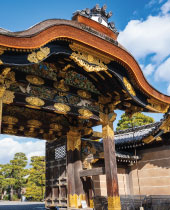If you have watched the recent Shogun series based on the James Clavell's 1975 novel Shōgun, which differed from the 1980 series by attention to authenticity and being spoken in Japanese, you may wonder what happened to the main samurai.

Portrait of Tokugawa Ieyasu
This character is based on Tokugawa Ieyasu (1543-1616), a military leader who reunified Japan and ruled from Edo, today Tokyo. In Kyoto, the Tokugawa shogun built Nijo Castle as his residence, which was completed by his grandson, Iemitsu 23 years later. The entire castle grounds, consisting of the Honmaru (main circle of defense), the Ninomaru (secondary circle of defense) and traditional Japanese landscape gardens are surrounded by stone walls and moats. The original five story castle keep tower no longer exists, destroyed by fire due to a lightning strike in the 18th century.

Nijo Castle, Kyoto aerial view

View of the Inner moat (photo credit: Paula Swart)

Ninomaru palace (photo credit: Martin Falbisoner)

Ninomaru Garden, a traditional Japanese landscape garden with a large pond, ornamental stones, and manicured pine trees. (photo credit: Paula Swart)
The Ninomaru Palace served as the residence and office of the shogun during his visits to Kyoto. Only the highest ranked visitors were allowed into the main audience room where the shogun would sit on an elevated floor. The corridor has a specially constructed floor, which functions like an alarm system. A series of clamps produce a sound like the cry of a nightingale whenever anyone walks on the floor!

Chinese-style Karamon Gate, the entrance to the Ninomaru (secondary circle of defense)
This historic site, regarded as the best surviving examples of castle palace architecture of Japan's feudal era, was designated a UNESCO world heritage site in 1994.

Room inside the Ninomaru Palace (photo credit: Zairon)
The palace rooms are tatami mat covered and feature decorated ceilings and beautifully painted sliding doors (fusuma). All the 954 paintings on sliding doors and murals at Nijo Castle are designated as nationally important cultural properties. They are by artists from the Kano school, which was the largest and most significant school in the history of Japanese painting.
A Canadian connection: In the early 20th century several screens from Nijo Castle were sold to raise funds for restoration. The famous American architect Frank Lloyd Wright, an avid collector of Japanese art who visited Japan several times, acquired one of them. In the late 1980s, Vancouver antique dealer Uno Langmann found an early 17th century six-fold screen depicting a pair of peacocks and a pine tree in a ruinous state in the US. He made several attempts to have it restored and decided to donate the screen to the Art Gallery of Greater Victoria. Research made it clear the screen had once belonged to Nijo castle. Finally, in 2008 the National Research Institute for Cultural Properties in Tokyo restored and conserved it free of charge, giving us an extremely important artifact with much historical significance.

Greeted by sake sellers outside Ninomaru Palace
(photo credit: Paula Swart, on her 2022 tour with the alumni UBC Travel Club)
I invite you to join me and a small group of travellers to explore the coexistence of nature, art, and architecture on a special tour to South Japan, which includes a close look at Nijo Castle, in fall 2024.
South Japan's Coastlines, Colours, and Culture
Sep 22 - Oct 5, 2024 | Led by Paula Swart
View the tour here.
A few spots are still available!
Sep 22 - Oct 5, 2024 | Led by Paula Swart
View the tour here.
A few spots are still available!



